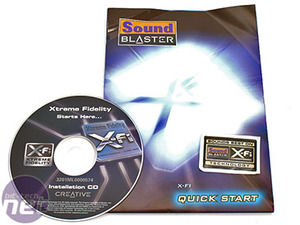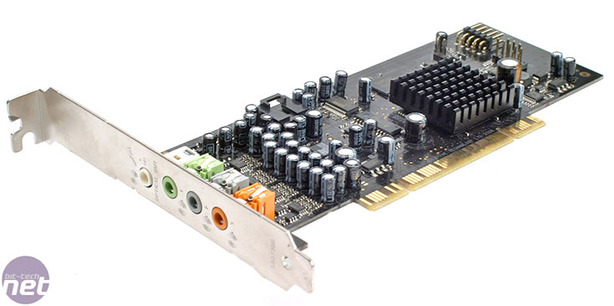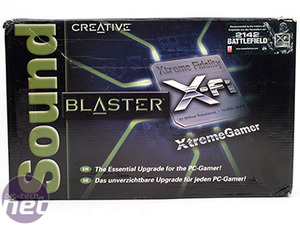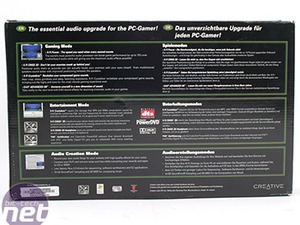
Manufacturer: Creative
UK Price (as reviewed): £61.79 (inc. VAT)
US Price (as reviewed): $84.99 (ex. Tax)
We don't hold it against Creative that it can't spell "extreme" because it has traditionally made great sound cards for gamers, no matter how much some would like some more competition. Since A3D died (boohoo!) the sound card market has been a little stagnant and was dominated by Creative's Audigy and X-Fi ranges. During that time the company has evolved its EAX technology and it is now up to version 5.0, for the latest games that support it.
Not only that, but Creative has the distribution that no other discrete sound card manufacturer seems able to mirror, you can buy its products everywhere. Until recently Creative was the sole manufacturer of its own sound cards, however it has now licensed the X-Fi technology to a few partners like MSI and Auzentech.
 The Creative X-Fi XtremeGamer is the new addition to a refreshed X-Fi range and is equivalent to your stripped down, super lean, bare basics X-Fi that still features all the necessary gaming additives. It still has the same X-Fi processor and 2MB of on-board memory cache necessary for processor operations, although it's missing the full 64MB X-RAM that's featured on the Fatal1ty and Elite Pro models.
The Creative X-Fi XtremeGamer is the new addition to a refreshed X-Fi range and is equivalent to your stripped down, super lean, bare basics X-Fi that still features all the necessary gaming additives. It still has the same X-Fi processor and 2MB of on-board memory cache necessary for processor operations, although it's missing the full 64MB X-RAM that's featured on the Fatal1ty and Elite Pro models.
Still sporting a black PCB we now find the card is only half height, making low profile gaming machines a much closer reality without having to resort to on-board sound or fishing around the net for a PCI riser. There's no half height bracket in the box though, meaning you'll have to mod your own or buy one from the Creative online store.
The revised PCB means that it no longer has the 26-pin AD_Link connector allowing the upgrade for the X-Fi I/O console, although given the very mainstream price we can't imagine too many people thinking about that particular upgrade. In addition there's still a 2x5-pin front panel HD audio connector and even an AUX input for an optical drive if you need it.
 The board still sports the same four 3.5mm jacks, although this time they're plastic now rather than metal, albeit coloured to allow ease of identification. It may not have the connectors of the previously reviewed HT Omega Claro or the Sodingo Inferno 7.1 but the XtremeGamer is only a fraction of the price and actually available to buy.
The board still sports the same four 3.5mm jacks, although this time they're plastic now rather than metal, albeit coloured to allow ease of identification. It may not have the connectors of the previously reviewed HT Omega Claro or the Sodingo Inferno 7.1 but the XtremeGamer is only a fraction of the price and actually available to buy.
There are just three jacks for 7.1 surround sound output, meaning the black and orange are now four pole instead of the standard three pole. They represent the rear left/right and side left then centre/sub and side right respectively. This means you have to have a compatible speaker set in order to take advantage of the full 7.1 setup. If you want just a 5.1 setup then you can use any standard 5.1 speakers using three, three pole 3.5mm jacks. The last (white) one is a dual Flexijack which features line in, microphone in and optical out. The optical out requires a toslink adapter which is again not supplied, but also available from the online shop.
 The board uses standard electrolytic capacitors from Luxon Technologies, a Taiwanese manufacturer with a sub-division dedicated to capacitor manufacturing so, despite these not offering the life of solid capped aluminium capacitors, they should last the distance. A capacitor's life is partially dominated by its operating temperature and sound cards really don't get that hot, unlike a motherboard or graphics card.
The board uses standard electrolytic capacitors from Luxon Technologies, a Taiwanese manufacturer with a sub-division dedicated to capacitor manufacturing so, despite these not offering the life of solid capped aluminium capacitors, they should last the distance. A capacitor's life is partially dominated by its operating temperature and sound cards really don't get that hot, unlike a motherboard or graphics card.
That doesn't mean Creative didn't feel the need to heatsink its 51m transistor X-Fi processor though, obviously it still kicks out more than a couple of watts and we recorded a toasty 51°C during testing. The heatsink seems almost welded on because it's completely unmovable, even after applying some considerable effort. Initially Creative designed the card without a heatsink in mind, but due to certain manufacturing variances it felt it was best include one to make absolutely sure the card runs stable.

UK Price (as reviewed): £61.79 (inc. VAT)
US Price (as reviewed): $84.99 (ex. Tax)
We don't hold it against Creative that it can't spell "extreme" because it has traditionally made great sound cards for gamers, no matter how much some would like some more competition. Since A3D died (boohoo!) the sound card market has been a little stagnant and was dominated by Creative's Audigy and X-Fi ranges. During that time the company has evolved its EAX technology and it is now up to version 5.0, for the latest games that support it.
Not only that, but Creative has the distribution that no other discrete sound card manufacturer seems able to mirror, you can buy its products everywhere. Until recently Creative was the sole manufacturer of its own sound cards, however it has now licensed the X-Fi technology to a few partners like MSI and Auzentech.
Box Contents:
In the box you don't get much, just the sound card, quick start leaflet and an driver and application CD. The Creative X-Fi XtremeGamer is the new addition to a refreshed X-Fi range and is equivalent to your stripped down, super lean, bare basics X-Fi that still features all the necessary gaming additives. It still has the same X-Fi processor and 2MB of on-board memory cache necessary for processor operations, although it's missing the full 64MB X-RAM that's featured on the Fatal1ty and Elite Pro models.
The Creative X-Fi XtremeGamer is the new addition to a refreshed X-Fi range and is equivalent to your stripped down, super lean, bare basics X-Fi that still features all the necessary gaming additives. It still has the same X-Fi processor and 2MB of on-board memory cache necessary for processor operations, although it's missing the full 64MB X-RAM that's featured on the Fatal1ty and Elite Pro models. Still sporting a black PCB we now find the card is only half height, making low profile gaming machines a much closer reality without having to resort to on-board sound or fishing around the net for a PCI riser. There's no half height bracket in the box though, meaning you'll have to mod your own or buy one from the Creative online store.
The revised PCB means that it no longer has the 26-pin AD_Link connector allowing the upgrade for the X-Fi I/O console, although given the very mainstream price we can't imagine too many people thinking about that particular upgrade. In addition there's still a 2x5-pin front panel HD audio connector and even an AUX input for an optical drive if you need it.

There are just three jacks for 7.1 surround sound output, meaning the black and orange are now four pole instead of the standard three pole. They represent the rear left/right and side left then centre/sub and side right respectively. This means you have to have a compatible speaker set in order to take advantage of the full 7.1 setup. If you want just a 5.1 setup then you can use any standard 5.1 speakers using three, three pole 3.5mm jacks. The last (white) one is a dual Flexijack which features line in, microphone in and optical out. The optical out requires a toslink adapter which is again not supplied, but also available from the online shop.

That doesn't mean Creative didn't feel the need to heatsink its 51m transistor X-Fi processor though, obviously it still kicks out more than a couple of watts and we recorded a toasty 51°C during testing. The heatsink seems almost welded on because it's completely unmovable, even after applying some considerable effort. Initially Creative designed the card without a heatsink in mind, but due to certain manufacturing variances it felt it was best include one to make absolutely sure the card runs stable.
Specific Components:

- 1. Wolfson Electronics WM8775 stereo analogue to digital converter which offers an analogue weighted 102dB signal to noise ratio at 48KHz with a recording range of 32kHz - 96kHz.
- 2. The Samsung K4S161622H-UC60 is a 16Mbit (2MB) SDRAM memory module rated at 166MHz and is specifically designed to meet RoHS standards with its lead-free design.
- 3. Creative X-Fi processor.
- 4. The Cirrus Logic CS4382 is an eight channel digital to analogue converter rated for up to 192KHz, with a dynamic range of 114dB and a -100 dB THD & Noise rating.

MSI MPG Velox 100R Chassis Review
October 14 2021 | 15:04










Want to comment? Please log in.